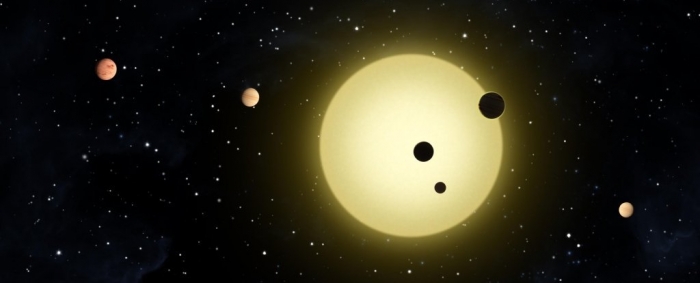If you look at a diagram of the Solar System, you can see that we're sort of all over the shop. We have planets of all shapes and sizes, and the distances between the orbits around the Sun vary wildly.
Scientists used to think this was probably pretty normal, but as we have learned more about exoplanets - thanks in large part to the planet hunting space observatory Kepler - several old assumptions have been challenged.
Using data from some of the thousands of exoplanets located using Kepler, Weiss and her team used the W. M. Keck Observatory in Mauna Kea, Hawaii to obtain high-resolution spectral data of 1,305 stars hosting 2,025 planets.
Using these data, the team was able to measure the sizes of the planets transiting, or passing in front of, their host stars. As they do so, the light from the star dims slightly, and it is the properties of this dimming that allows the team to calculate the planet-to-star radius ratios for every orbiting body.
For the study, the team focussed on 909 planets divided between 355 multi-planet systems, located mostly between 1,000 and 4,000 light-years from Earth.
And they tended to fall into two patterns, which the researchers were not expecting. Firstly, the planets tended to be around the same size as their neighbours, meaning planet sizes in exoplanet systems are often roughly uniform.
Secondly, the distances between planetary orbits were fairly even.
"The planets in a system tend to be the same size and regularly spaced, like peas in a pod. These patterns would not occur if the planet sizes or spacings were drawn at random," Weiss said.
In other words, if the size of one planet or orbital distance in a system is known, astronomers could make a more accurate prediction about the size or orbital distance of another planet than drawing a random planet out of a hat to construct an artificial planet system.
They also found only a very weak correlation between star mass and planet radius, which means it's probably not stellar mass that enforces planet size.
And, they found, when there is some size variation in a planetary system, the planet closest to the star will be smaller, especially if the planet has a short orbital period - possibly because of photoevaporation.
This finding has implications about how planetary systems form - and gives us some clues as to how our budding Solar System was different.
The most accepted hypothesis currently is that the protoplanetary disc of dust and debris that surrounds a newborn star gradually coalesces and accretes into planetary bodies. If the disc is relatively even, it's reasonable to conclude that even planetary systems, such as those observed by the researchers, can evolve from this disc.
So what happened with the Solar System? The researchers believe Jupiter and Saturn had something to do with it. The two gas giants formed early in the Solar System's history, and there's evidence to suggest that they disrupted its early structure in some way.
So a more uniform planetary system is one that probably has had relatively few disruptions. In order to test this, the team's next project will be to look for Jupiter-sized exoplanets in multi-planet systems, and see if theses systems are consistent with the hypothesis.
The team's research has been published in The Astronomical Journal.
More about: #Solar-System
















































